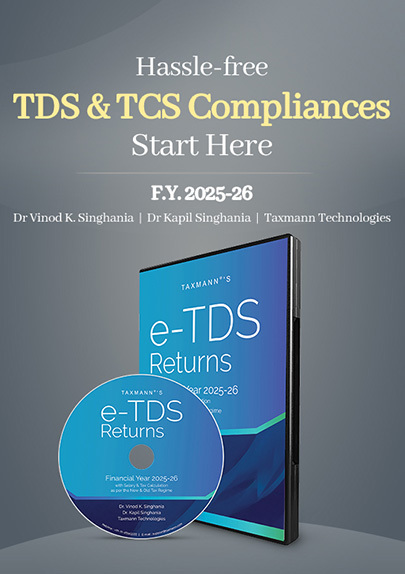[Opinion] Artificial Intelligence (AI) in Taxation | Enhancing Compliance, Efficiency, and Policy in India
- News|Blog|Income Tax|
- 3 Min Read
- By Taxmann
- |
- Last Updated on 16 January, 2025

Sachin Mishra & Mahi Agrawal – [2025] 170 taxmann.com 293 (Article)
Artificial Intelligence (AI) has become an influential tool that has not only changed the face of the legal system but has also made a considerable impact on tax administration across the world. There is no doubt that AI has the potential of changing traditional approaches in the future. Despite some doubts about the effectiveness of the AI, its application in the legal field is highly noticeable, influencing all aspects of the legal system, including government and tax administration, taxpayers, and legal professionals. In simple terms, AI can be defined as the use or development of intelligent machines or computer programs that have some attributes of human intelligence including language processing, image recognition, problem solving and learning from data input into them and output from them.
In India, which has a complex and vast tax system, AI can be a revolutionary tool to simplify the system, enhance transparency, and address tax frauds. AI can effectively work with large data sets, identify trends, and offer valuable insights, which is why the use of AI in tax administration is expected to considerably enhance efficiency. The United States, Australia, and Canada have already developed their tax systems through the application of technologies such as machine learning, data analytics, and natural language processing, etc. India has also joined the AI bandwagon with initiatives like the Goods and Services Tax Network (GSTN) and Project Insight among others. This paper examines how AI is being incorporated in the Indian tax system, the developments that are shaping the adoption of the technology, the issues that needs to be solved and may provide insight on the direction that AI may take in transforming taxation in the future.
1. Global Trends in AI-Driven Tax Systems
The global landscape of tax administration is going through a major transformation as countries are trying to improve and speed-up their delivery of services and tax compliances, by integrating the use of Artificial Intelligence and Machine Learning in their tax systems. For instance, in the United States, the Inflation Reduction Act of 2022 has provided the Internal Revenue Service (IRS) the opportunity to implement the Paperless Processing Initiative, through which it plans to improve the processing time and the rate of refund returns. The IRS has also been using artificial intelligence in solving complex partnership return taxes under the Large Partnership Compliance program, thus proving that the use of artificial intelligence is useful in dealing with complex structures.
Furthermore, Australia has made significant strides in utilizing advanced technologies for tax assessments, with the Australian Taxation Office (ATO) developing sophisticated machine learning algorithms to process vast amounts of data for more timely tax assessments. The ATO’s “Smarter Data” program uses AI to manage one of the largest data collections in the Australian government, optimizing services by providing timely analysis, improving resource allocation, and offering more effective taxpayer services. Additionally, the ATO pre-filled over 85 million pieces of data in 2020, demonstrating the efficiency of their AI-driven systems. Other tax authorities around the world are also following suit. The Canada Revenue Agency, the General Taxation Department of Vietnam, and the Swedish Tax Agency have all invested in AI technologies to streamline their operational processes. These implementations range from automated data analysis and risk assessment to improved taxpayer services and fraud detection.
2. AI Adoption in Indian Tax Administration
India’s journey towards AI integration in tax administration is a part of a broader flagship digital transformation initiative. Aligning with the objectives outlined in the National Strategy for Artificial Intelligence, the government has implemented the Goods and Services Tax Network (GSTN). It uses advanced data analytics and AI to facilitate tax compliance and detect fraud.
The Central Board of Direct Taxes (CBDT) has been at the forefront to leveraging AI for tax administration. In 2019, the CBDT launched Project Insight (discussed ahead), a dynamic platform that uses big data analytics to gather information from various sources, including social media, to identify potential tax evaders. Moreover, the recent amendments related to faceless assessments and appeals to the Income Tax Act, 1961, have helped reduce human intervention and enhance transparency in tax assessments, aligning with the government’s vision of a technology-driven tax administration system.
Click Here To Read The Full Article
Disclaimer: The content/information published on the website is only for general information of the user and shall not be construed as legal advice. While the Taxmann has exercised reasonable efforts to ensure the veracity of information/content published, Taxmann shall be under no liability in any manner whatsoever for incorrect information, if any.

Taxmann Publications has a dedicated in-house Research & Editorial Team. This team consists of a team of Chartered Accountants, Company Secretaries, and Lawyers. This team works under the guidance and supervision of editor-in-chief Mr Rakesh Bhargava.
The Research and Editorial Team is responsible for developing reliable and accurate content for the readers. The team follows the six-sigma approach to achieve the benchmark of zero error in its publications and research platforms. The team ensures that the following publication guidelines are thoroughly followed while developing the content:
- The statutory material is obtained only from the authorized and reliable sources
- All the latest developments in the judicial and legislative fields are covered
- Prepare the analytical write-ups on current, controversial, and important issues to help the readers to understand the concept and its implications
- Every content published by Taxmann is complete, accurate and lucid
- All evidence-based statements are supported with proper reference to Section, Circular No., Notification No. or citations
- The golden rules of grammar, style and consistency are thoroughly followed
- Font and size that’s easy to read and remain consistent across all imprint and digital publications are applied



 CA | CS | CMA
CA | CS | CMA
